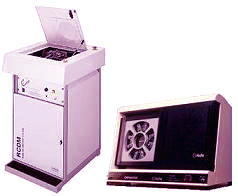ESD Sensitivity
Classification Levels
Different
devices have different levels of sensitivity to electrostatic discharge,
or
ESD. Thus, there
needs to be a way to distinguish ESD-sensitive devices from those which
are not as vulnerable to ESD. Each of the
ESD models used in ESD sensitivity testing
has its own classification system for categorizing devices according to
their ESD sensitivity.
The ESD sensitivity of a device is usually specified in terms of the
highest ESD test voltage that it passes and the lowest ESD test voltage
that it fails per ESD model. Thus, ESD sensitivity is often expressed as
a range of ESD voltage that a device can safely be subjected to for each
of the ESD models. The following tables
present the ESD sensitivity classification levels defined by the ESD
Association for each ESD model.
Table 1.
ESDS Component Sensitivity Classification - Human Body Model
(Per ESD
STM5.1-1998*)
|
Class |
Voltage Range |
|
Class 0
|
< 250 volts
|
|
Class 1A
|
250 volts to < 500 volts
|
|
Class 1B
|
500 volts to < 1,000 volts
|
|
Class 1C
|
1000 volts to < 2,000 volts
|
|
Class 2
|
2000 volts to < 4,000 volts
|
|
Class 3A
|
4000 volts to < 8000 volts
|
|
Class 3B
|
> = 8000 volts
|
Table 2.
ESDS Component Sensitivity Classification - Machine Model
(Per ESD STM5.2-1999*)
|
Class |
Voltage Range |
|
Class M1
|
< 100 volts
|
|
Class M2
|
100 volts to < 200 volts
|
|
Class M3
|
200 volts to < 400 volts
|
|
Class M4
|
> or = 400 volts
|
Table 3.
ESDS Component Sensitivity Classification - Charged Device Model
(Per ESD STM5.3.1-1999*)
|
Class |
Voltage Range |
|
Class C1
|
<125 volts
|
|
Class C2
|
125 volts to < 250 volts
|
|
Class C3
|
250 volts to < 500 volts
|
|
Class C4
|
500 volts to < 1,000 volts
|
|
Class C5
|
1,000 volts to < 1,500 volts
|
|
Class C6
|
1,500 volts to < 2,000 volts
|
|
Class C7
|
=>2,000 volts
|
*Reference:
www.esda.org
A complete ESD
characterization of every new product prior to its release is highly recommended.
Complete ESD characterization consists of subjecting
the device to ESD testing for all of the three ESD models,
i.e., HBM, CDM, MM. Data for one ESD model can not be substituted
for those of the other ESD models, since good ESDS test results for one
model doesn't necessarily mean that the test results will also be good
for the other ESD models. Thus, a
company that takes its ESD program seriously must equip itself with ESD tester(s)
capable of performing the required ESD
tests for each of the test models.
|
 |
|
Figure
1. Examples of ESD Testers
|
See also:
What is ESD?;
ESD Models;
ESD Test Waveforms;
ESD Failures; ESD Standards;
ESD
Controls;
ESD Audit Checklist; The Triboelectric
Series
Back to Top
Home
Copyright
©
2001-Present
www.EESemi.com.
All Rights Reserved.

